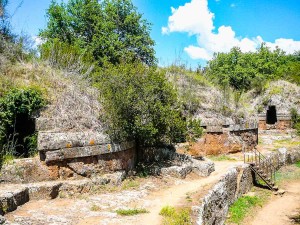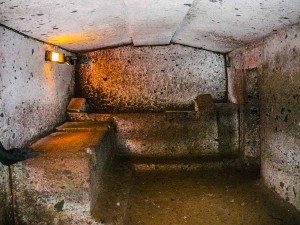
©Bigstock.com/silviacrisman
When thinking about Italy’s ancient history, the first name that comes to mind – obviously – is Rome. The former global power, the tremendous imperium, the unique architectural and cultural heritage… but what / who was before the Romans? The Etruscans populated the northern part of Central Italy from around 800 BC until far into the second half of the 1st century BC and left many a fascinating cultural evidence still researched intensely to this day; party due to the many mysteries surrounding them. The old burial grounds and rites of the Etruscans are regard as exceedingly interesting. As such, you’ll hardly be surprised to hear that the Etruscan Necropolises of Cerveteri and Tarquinia, two especially grand examples of such grounds, were declared UNESCO World Heritage Site in 2004.
About the Etruscan culture
How the Etruscan culture actually came to Etruria – their heartland’s name, which stretches across most of today’s Tuscany, northern Lazio and parts of Umbria – is unknown. Experts believe that migration and emergence of said culture were not too far apart. There are still many theories about where the Etruscans originated – some think they immigrated from Lydia (today’s Turkey), others believe they emerged from the Iron Age Villanova culture of Bologna. First documented grave finds date back to the 9th century BC. Various necropolises reflect significant changes in the burial rites over the course of the centuries. Several practices were carried out either at the same time or after one another allowing the historic placement of the various sites.
In fact, far too little is known about the Etruscans today. Remains of Etruscan architecture are extremely rare – only very few foundations here and there, mostly of temples, survived – objects of art depicting the transition from oriental to Greek imprint are few and far between. The language, too, has only been rudimentarily studied at best due to lack of extensive written records. Thus, the Etruscan culture still captivates researchers to this very day. While it mostly disappeared upon assimilation into the Roman Empire in pre-Christian times – the granting of unlimited civil rights around 90 BC put a formal end to Etruscan history – the hunt for clues remains an exciting challenge.
The Necropolises of Cerveteri

©Bigstock.com/silviacrisman
Our first stop takes us near Rome, approx. 42 km west of the capital. The friendly town of Cerveteri is situated between the Monti Sabatini and the Tyrrhenian Sea. Founded by Etruscans, it was originally called Caere or, to give it its Etruscan name, Caisra. Iron ore exports turned Cerveteri into one of the largest and most populous towns in Etruria, about 15 times its current size.
Where there was a lot of living, there was a lot of dying. Admittedly, that sounds quite morbid, but this mere fact grants you fascinating insights into a culture still heavily shrouded in mystery. The two Necropolises of Cerveteri with their thousands of graves were laid-out like a sort of city map with various squares and districts. Size and burial equipment depend on both the era and the importance of the family. Among the most important tombs are:
- Tomba dei Capitelli: The tomb of the capitals looks like typical Etruscan dwellings. Its flat roofs with timber boards and straw convey a classic, almost family-like look.
- Tomba dei Vasi Greci: A long corridor, highly evocative of an Etruscan temple, leads into this 6th century BC burial site. If you’re wondering why this area is called “Tomb of the Greek Vases”, well, see for yourself.
- Tomba dei Rilievi: Presumably only established around 300 BC and, thus, one of the youngest graves, a long stairwell leads you to a magnificent hall supported by massive pillars. Elaborately decorated reliefs around the 13 burial alcoves line this site granting exciting insights into the life (and death) of an affluent Etruscan family.
- Tomba della Cornice: Another long corridor after the ascending entrance leads to this final resting place. Two smaller side rooms with two deathbeds each aside, the simple yet imposing architecture of the three main death rooms in the central room knows to impress.
- Tomba Regolini-Galassi: Remember the oriental imprint we mentioned earlier? This feature of early Etruscan culture is visible throughout this 7th century BC tomb, likely the oldest accessible tomb of the city. Originally, it was richly lined with gold. Many of the elaborate burial objects are currently exhibited in regional, even international museums.
Cerveteri is faced with the rather severe issue of grave robbery. The town isn’t even close to having fully explored all tombs, even less are accessible to the public. Due to the sheer mass of graves, not all entrances can be monitored allowing grave robbers with high-grade technical equipment to do their appalling deed. International auction houses in London and Los Angeles, among other cities, sell such robbed items every once in a while causing understandable upset.
Tarquinia’s Necropolises
Called Tarchuna in Etruscan times, Tarquinia played an important role in ancient culture as well. Founded during the times of the Villanova culture, the town with high tactical significance was surrounded by an eight-kilometre-long wall. Situated in north-western Lazio, it is now predominantly known for its excavation sites. The main attraction, if you will, is the Necropolis of Monterozzi at the southeast town limits where around 6,100 tumulus-covered burial chambers carved in stone were created between the 6th and the 2nd century BC. Around 150 chambers are decorated with frescoes. They play a key role in Etruscan art and are absolute must-sees. Visit the following burial sites:
- Tomba del Cacciatore: You’ve always wanted to know what the inside of an Etruscan hunting pavilion looks like? This 4th century BC tomb with its wooden structure provides you with thrilling insights.
- Tomba della Caccia e della Pesca: The tomb of hunting and fishing displays scenes of these very aspects of life as well as a Dionysian dance. You also get to see portraits of the buried family making this site one of the best-explored in all of Tarquinia.
- Tomba delle Leonesse: Enjoy deep insights into the life of Etruscan aristocracy surrounded by soaring birds and leaping dolphins. An ash container suggests that the tomb was intended for cremations.
- Tomba degli Auguri: Sadly, this burial chamber, like so many other Etruscan tombs, fell victim to grave robbers. You can still the marks of the deathbeds on the ground. Wrestling scenes on the wall depict what might’ve been the predecessor of Roman gladiator fights.
- Tomba dei Tori: This is the only Greek-themed tomb in Tarquinia. A depiction from the life of the hero Achilles – a typical motif of Greek vases – lines this mythologically inclined resting place.
If you’ve always wanted to enjoy deep insights into the unique Etruscan culture, this trip to north-western Lazio is a must. The necropolises display various aspects of life (and death) across half a millennium with many other excavation sites and museums in close proximity. It doesn’t get any more Etruscan than this!